- Author
- A.N. Other
- Subjects
- Biographies and personal histories, RAN operations, History - WW2
- Tags
-
- RAN Ships
- None noted.
- Publication
- June 2021 edition of the Naval Historical Review (all rights reserved)
By Hector Donohue
Port Clearance Parties, or P Parties, were established in the Royal Navy (RN) in late 1943 and were trained to clear the ports and harbours of Northern Europe. The P Parties, acting as human minesweepers, followed up the invading forces to clear the ports of underwater mines and booby-traps laid by the Germans which were inaccessible to the standard methods of minesweeping. What is not well known is that the P Party concept was developed by two RANVR officers who were engaged in underwater mine disposal at HMS Vernon – Lieutenant Commander Stuart Mould GC, GM, and Lieutenant Leon Goldsworthy GC, DSC, GM. Two other RANVR officers commanded a P Party in Europe, Lieutenant Maurice Batterham and Lieutenant George Gosse GC. It was the P Party activities in the ports of Europe and UK which ultimately led to the introduction of clearance diving in both the RN and RAN.
The Beginning
Promoted Acting Lieutenant Commander in January 1943, Mould, who was serving in the Enemy Mining Section (EMS) at HMS Vernon, began work with the Admiralty Experimental Diving Unit (AEDU) to develop a self-contained underwater breathing apparatus for mine disposal. John Stuart Mould (known as Stuart) qualified in mine disposal in October 1940 and had achieved considerable distinction in many dangerous mine disposal operations which, to quote the London Gazette, ‘…include the recovery, rendering safe and investigation of the first German magnetic/acoustic unit and moored magnetic mine.’ He was the first officer to be awarded both a GC and GM.
Leon Goldsworthy qualified in mine disposal in August 1941 and had transferred to EMS at Vernon in January 1943. He had also distinguished himself in mine disposal operations.
AEDU had decided that, as oxygen diving was so dangerous below 10 m it was necessary to develop the use of oxygen-nitrogen mixtures in self-contained breathing apparatus for use at greater depths. The oxygen breathed could be diluted with nitrogen, although not so much as in air, and this would allow diving to considerably greater depths without the risk of oxygen poisoning.
Together, Mould and Goldsworthy developed the Vernon Diving Suit, a compromise between the Admiralty Standard Diving Dress and the Salvus Self Contained Oxygen Recirculation Breathing Equipment. The Vernon, officially known as the Mine Recovery Suit or MRS, was essentially a walking suit, good enough for mine disposal and recovery dives to 180 feet, but unsuitable for large area bottom searches.
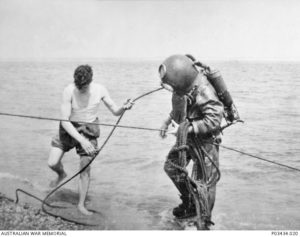
In May 1943 Allied forces entered Bizerta on the north coast of Tunisia, and north coast of Tunisia, and following the defeat of the German/Italian Army found a large load of German ground mines in two lighters moored in the harbour. The Germans had planned to deploy them in the harbour before their final retreat. The news of this find raised concerns within the Director of Minesweeping Division in the Admiralty. Commander C.E. (Bill) Hamond, already part of the planning of Operation Overlord, realised the very success of the operation was dependent upon open ports to replenish allied supplies; an impossible task if these ports were littered with sea mines. Most importantly, this role could not be filled by a conventional minesweeper – it required an alternative approach.
Hamond, who had won a DSC during World War I, had retired in 1927 and rejoined in 1939. His previous posting was Commanding Officer Mine Recovery Flotillas at Vernon where he received a DSO and Bar to his DSC. During his time at Vernon he got to know Mould and was aware that he was working on self-contained diving equipment. He approached Mould to join him in working to provide a solution to the issue.
On a wet Sunday afternoon in Vernon, Mould and Goldsworthy conceived the idea of using squads of divers to locate, immobilise and destroy mines. Several large teams of divers were required and it was essential that they were highly mobile and able to dive and search anywhere at short notice. Wire jackstays and sinkers would be laid out across the harbour floor to provide a grid. Teams of divers would conduct a methodical search using the jackstay to guide their movement searching one side and then, on return, the other. The jackstay would then be recovered and moved to the next area.
Mould approached Hamond with this concept, which he endorsed and had Mould posted to his staff in Admiralty to develop the P Party concept. Goldsworthy volunteered to assist but this was refused, and he remained in Vernon for underwater mine disposal, using the suit he helped to develop. He worked closely with Vernon’s Mine Recovery Flotilla, a group of auxiliary vessels fitted for mine location and recovery. During this period, he was awarded the George Medal (April 1944), Mentioned in Dispatches (August 1944) the George Cross (September 1944) and Distinguished Service Cross (January 1945).
Whilst Hamond investigated the provision of the jackstay equipment Mould was looking for suitable diving equipment to conduct underwater searches as he needed something less bulky and more mobile than the Vernon suit. His first choice was the Sladen suit which had been designed for charioteers who manned the human torpedoes. It used closed-circuit oxygen breathing, which could be adapted to mixture breathing, but Mould found there were no suits available as they had already been allocated to a higher priority activity. He then investigated another type of self-contained breathing apparatus, the Admiralty Neck Salvus gear. The principle was the same as that of the Salvus used for shallow water diving, but the breathing bag was of the neck type, and the gas cylinder with its closing valve, reducing valve and carbon dioxide absorbent canister were carried at the left-hand side of the diver. These were available for P Parties.
The next step was to obtain Admiralty approval to proceed. Hamond and Mould presented their proposal to a meeting of senior officers who reluctantly endorsed the program pending an alternative, less perilous scheme being found.
From Concept to Reality
The next step was to find suitable personnel and volunteers were called for ‘a hazardous operation’. Besides mine disposal officers, each Party was to consist of a petty officer, two leading seamen, and about thirty sailors who would be divided into young would-be divers and older hands for diver attendant and maintenance.
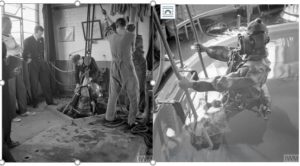
Selections were made from the many volunteers and by August 1943 two P Parties, consisting of two officers and 40 sailors each, were formed and commenced training. They moved to living quarters at the naval depot at Forest Gate, East London. Mould managed the initial diving training at Siebe Gorman’s works at Tolworth near Kingston, South London. Meanwhile Hamond supervised the training of the maintenance group in handling jackstays and boat work. To bring the divers and maintenance personnel together, they trained at Horsea Lake near Portsmouth, before spending the winter training in London’s docks.
Administration of the growing number of people and equipment necessitated the provision of a ‘base’ and HMS Firework was commissioned in Vintry House in central London, overlooking the Thames and surrounded by bomb damaged buildings. Whilst the Admiralty had provided a small but makeshift base for P Parties, they were not yet ready to put complete confidence in the project and continued looking for another method of port clearance which could supersede human minesweepers. In the event none was found.
By D-day two Parties, now designated 1571 and 1572, were both fully trained, with two more Parties 1573 and 1574 under training. In addition to diving and maintenance work all had been trained in mine and bomb recognition, the avoidance of booby traps, the use of automatic weapons and field work, as well as reaching a high level of physical fitness. Hamond himself was found to be unfit for active duty and Commander F. L. de Spon was appointed to be in overall charge of the P Parties on the Continent. Hammond remained involved as liaison with the Director of Minesweeping.
The Parties went into action on 25 June 1944 accompanying US forces to Cherbourg with the object of opening that important port as soon as possible. They were successful almost from the beginning and through their efforts, new types of mines, demolitions charges, booby traps and enemy equipment were successfully recovered. Both Parties were relieved by 1573 and 1574 during the period.
Churchill visited Cherbourg in July 1944 and later wrote in his History of the Second World War: ‘The basins of the harbour were thickly sown with mines. A handful of devoted British divers were at work day and night disconnecting these at their mortal peril. Warm tributes were paid to them by their American comrades.’ On 14 August US authorities at Cherbourg were informed the port was clear. P Parties had proved themselves and had earned the recognition they deserved, with the concept now fully endorsed by the Admiralty. Their fears of excessive casualties amongst the divers had not been realised and the ports in Normandy were cleared without a single loss.
From Strength to Strength
The four P Parties together with a Dutch Party (3006), worked their way along the coast of France and Belgium, sometimes bypassing unfinished battles and still-contested ports to return later. The clearing of Antwerp harbour and its approaches was a tremendous undertaking, much of it carried out under enemy fire. Over 745,000 square metres were searched.
Meanwhile in UK an organisational change was made which proved most beneficial to P Parties. On 1 October 1944, all naval diving was transferred to the Director of Torpedoes and Mining and with this, the opportunity to create a real P Party base at Brixham in South Devon as an offshoot of Vernon at Portsmouth. A large MTB base was about to pay off and had the offices, accommodation and support equipment ideally suited for the growing P Party program, both for training and team rest from active duty. Originally it was intended that the base be developed for diving training but with P Parties growing so fast they soon filled the base and the diving training was shelved. Firework was decommissioned on 27 October 1944 and HMS Vernon (D) was commissioned the same day under Commander A. R. Alston OBE, RN, coming under the Naval Officer in Charge Dartmouth for administration. Alston was an experienced torpedo officer who had served in Vernon’s Mining Department at the beginning of the war and subsequently in the Admiralty within the Directorate of Torpedoes and Mining.
The Brixham base was later joined by the Admiralty Experimental Diving Unit and the Deep Diving Tender HMS Tedworth.
The Parties were strengthened before deploying to France and each consisted of three officers, twenty divers, fifteen maintenance hands, four Royal Marine drivers, one sick-bay attendant and one cook. They also had one pick-up van and four three-ton lorries. Once on the Continent they generally added a few jeeps to this circus. In Europe the Parties moved to Belgium and Holland with the gigantic task of clearing the port of Antwerp, a vital job which was cleared in record time. The clearance of Terneuzen, Zeebrugge, the South Beveland Canal and Flushing was completed by the end of December. All Parties returned to Vernon (D) for rest, further training and re-equipment. By this time, two RANVR officers had joined, Lieutenants Maurice Batterham and George Gosse.
When the Allied drive into Germany began in the spring of 1945, six P Parties deployed for port clearance in Holland and north west Germany. They included 1575 which had trained in Vernon (D), and the Dutch team. They cleared the ports in Amsterdam, Rotterdam, Hamburg and Bremen. Bremen proved the greatest test to their courage and skill. Intelligence reported some sixty mines had been laid. No information was held on where the ordnance was, and the opening of the port depended on the P Parties. Although situated in the British zone, the port of Bremen had been allocated to the US to give the American forces an outlet to the sea.
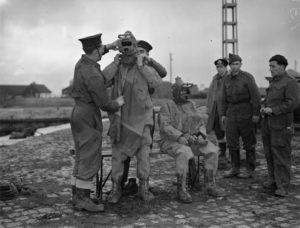
By June, all six teams converged in Bremen and altogether they accounted for 48 mines before returning to the UK from late July, with the final team returning in September. This was the end of the Continental campaign by the P Parties and despite the Admiralty fears at the beginning, there were no casualties. Overall they spent some six hundred days in actual diving; a total of more than 1.9 million square metres had been searched; 159 mines, 50 Tellermines, 121 charges and one V1 rocket had been found and dealt with by the Parties.
The British Naval Commander-in-Chief, Admiral Sir Harold M. Burrough GCB, KBE, DSO sent the following signal: ‘With the completion of their tasks at Bremen, Naval P Parties bring to a close a magnificent job of work carried out under dangerous and arduous conditions in harbours of France, Belgium. Holland and north-west Germany. Please convey to all concerned my thanks and high appreciation for all their efforts. I wish them all the best of good luck in the future.’
Maurice Samuel Batterham
Maurice Batterham joined the RANVR as a Sub Lieutenant in August 1942. He qualified in bomb disposal at the Army Base at Bonegilla in October 1942 and joined HMAS Melville in Darwin in December for diving and bomb and mine disposal duties. He was promoted to Lieutenant in January 1943 and qualified as a diver in HMAS Penguin in October 1943. He was involved in salvaging materials from sunken ships in the wake of the Japanese bombings and rendering bombs safe as well as several Japanese mines washed ashore. In October 1944 he was sent on exchange service with the RN and joined Vernon (D).
Batterham was described by Vernon (D) First Lieutenant, Lieutenant Commander L. M. Bates RNVR as ‘a tall, looselimbed Australian who should have been a Texas ranger and not a diver. He was popular with everybody and affectionately known, in the nicest way, as “Batts”’.
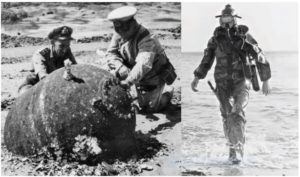
In November Batterham was sent to relieve Lieutenant W. Baily RNVR in command of Party 1574 at Flushing in Holland. They uncovered the first German antennae mine and a cleverly contrived booby trap consisting of waterproofed Teller (anti-tank) mines. Training regarding booby traps paid off and the team’s strict rules of procedure ensured constant vigilance by all team members. They also recovered many ground mines ashore. When conditions were unsuitable for diving, they carried out bomb disposal duties, dealing with many charges and unexploded bombs.

The team returned to Brixham late December and Batterham remained in command, undertaking refresher training and practice in the use of the Vernon mine-recovery suit. In the New Year he took the team to the Thames Estuary searching for abandoned German mines and missing British controlled mines. He handed over to Lieutenant P. R. F. Britnell RNVR in February 1945.
In May 1945 Lieutenant Commander H. J. Horan RNVR took sick as the team was at Lekhaven, in the port of Rotterdam, and Batterham was rushed from Vernon (D) to take his place in command of P Party 1572. Some German divers had recovered several German S mines but of those known to have been laid, one was missing. After an extensive two day search the missing mine was located. The team also found and buoyed a German midget submarine. Batterham then took the Party to Hamburg where no mines were found but many wrecks were located. In June the Party joined the other five in Bremen and together with Party 1575 they found and buoyed four mines which were countermined by the Dutch Party. They continued at Bremen until late July and returned to Brixham.
George Gosse
On 21 October 1940 Gosse enlisted as an Ordinary Seaman in the RANVR and was commissioned Sub Lieutenant in April 1941 while posted to the officer training school HMS King Alfred at Hove in Sussex. He qualified as a bomb and mine disposal officer in July 1941 and was posted to HMIS Hooghly at Calcutta, India as mine disposal officer, a surprising posting given the minimal mine threat there and the significant activity in the UK. Official reports noted his reliability, keenness and ingenuity. Always cheerful under difficulties, he got on well with both officers and men and exhibited ‘a daring character and a good knowledge of mines in which he is very interested’.
He was made Provisional Lieutenant in February 1942 and after three years looking after mines washed ashore, he returned to the UK. In November 1944 he joined Vernon (D).
As Bates described it: ‘Gosse was a bearded Australian who had come to swell the numbers and talents at Vernon (D). He fitted in so easily that it was soon difficult to recall a time when P Parties had been without him.’ Soon after Christmas, Gosse completed a diving course.
Gosse took command of P Party 1571 in March 1945 and deployed to the Continent awaiting the entry of the Allied armies into German ports. They joined the US Command Task Force at Verden some 35 km south of Bremen while they waited for Bremen to fall. After ten days they became the first P Party to enter Bremen when they conducted a reconnaissance of the port. It was in wild disorder with dock installations wrecked and neither power nor water available. There were many mines within the docks and Party 1571 moved to the outskirts of the port, commandeering suitable accommodation in a nearby farmhouse. The Party started diving on 3 May in the Ubersee Hafen where nine mines had been reported laid.
After a few days searching, on 8 May, a diver reported an object he thought to be a mine and buoyed it. Sub Lieutenant W K Heath RNVR then dived on the object and reported it was a German type GD magnetic/acoustic/pressure mine known as the ‘oyster’.
At about 1800 the next day when diving had finished, Gosse dived (using a Vernon suit) on the mine and became the first to render safe an armed GD pressure mine. Even with the aid of a waterproof torch, he could not see the device in the mud and proceeded to work by touch. He also had difficulty in stabilising his buoyancy and had to secure himself to the mine’s marker-buoy rope to keep his depth steady.
Using tools which he had improvised, Gosse removed the primer release and then extracted the primer ‘about eighteen inches (46 cm) down a two -inch tube’. He had interrupted the detonation train and the mine was safe. While he was releasing himself from his makeshift tether, there was a small explosion. Later examination of the landed mine showed that water had entered through the primer tube and operated a mechanism designed to respond to changing water pressure and trigger the detonator if the mine were raised. He later defused two similar mines and on both occasions the detonator fired before the mine reached the surface.
The Party returned to Brixham in late July for rest. Gosse was awarded the George Cross for his actions in disarming mines in Bremen Harbour during May 1945.
On 29 April 1946, Gosse was informed of his award of the George Cross. Humoured by the award for tasks he actually enjoyed, Gosse is reported to have mused to a reporter: ‘George Gosse…George Cross…sounds very much like a test of sobriety’.
Far East P Parties
To assess the need for P Parties as Japan retreated, the Admiralty sent Mould to Ceylon and Australia in early 1945 to investigate. As a result, in June 1945 two new P Parties were formed for service in the Far East, to be under the overall command of Commander John Mould who was to be on the staff of C-in-C East Indies.
The first Party, 2443, was under Lieutenant George Gosse and the second, 2444, under Lieutenant Maurice Batterham, both of whom were to be promoted to Lieutenant Commander and assisted by three RNVR mine disposal officers. Gradually, when they could be spared, the Far Eastern officers were to return from the Continent.
Goldsworthy, who was serving as a British Naval liaison and intelligence officers with the US Navy in the Pacific, was recalled from the Pacific in July to train the Parties. The Parties formed in August and commenced training.
However, after the surrender of Japan in September 1945 it was determined that the Japanese had not undertaken the anticipated anti-invasion measure of mining their ports and harbours and hence there was no need for port clearance activity. Consequently, the two Parties were disbanded in October 1945.
The Legacy
In October 1945 preparation for the final dissolution of P Parties began. Admiralty had decided one P Party wouldremain based at Vernon, to deal with residual suspected unexploded ordnance around the UK coast. HMS Vernon (D) was paid off on 30 November 1945, thirteen months after commissioning.
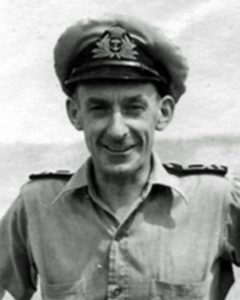
The First Lord of the Admiralty, the Right Honourable A. V. Alexander (later Earl Alexander of Hillsborough) sent the following signal: ‘On closing down your establishment at Brixham, I should like to express to you and your staff my admiration of the splendid work done by P Parties. The ingenuity displayed and courage shown by these Parties have contributed to the success of the operations of the United Nations.’
In 1948 the RN determined that P Party divers would be known as Clearance Divers. A Confidential Admiralty Fleet Order was issued on 3 December 1948 promulgating the policy that P Party Divers were in future to be known as Clearance Divers. Divers (C) would be specialist divers and when available, allocated to three teams: Home, Mediterranean and Far East Fleets.
Lieutenant Commander M. S. Batterham RANVR was serving in the Naval Ordnance and Underwater Weapons Directorate in Navy Office at the time and initiated the requirement to establish a similar organisation in the RAN. He raised the proposal in January 1951 which was supported by the Naval Staff and approved by the First Naval Member, Vice Admiral Sir John Collins on 2 February 1951.
Epilogue
Mould’s RANVR appointment was terminated on 26 November 1945 in Britain. He obtained a post as an architect with the allied military government in Germany and helped with that country’s reconstruction.
In December 1945 Goldsworthy was appointed to the British Naval Technical Mission to Japan and assisted in compilation of a report on Japanese underwater weapons. He returned to Australia in HMS Formidable arriving Sydney in April 1946 and was demobilised in May.
Having been promoted Acting Lieutenant Commander on 30 September 1945, Gosse was demobilised on 20 March 1946 and returned to his home in Adelaide.
Batterham returned to Australia in January 1946 where he was involved in post-war bomb and mine disposal in the islands to Australia’s north. He was appointed to Navy Office in 1948 and, after initiating the requirement to establish a Clearance Diving Branch in the RAN in 1951, was the driving force behind the early development of clearance diving in the RAN.
Batterham was awarded the OBE for ‘courage and devotion to duty’ in June 1952. His citation noted that: ‘Since 1943 he had been engaged intermittently on mine clearance and other duties of a hazardous nature…including the clearance of former enemy-held ports in Europe and RMS duties in Rabaul after the Japanese surrender. By his skill, courage and leadership he was an outstanding example to his subordinates’. He was promoted to Commander in June 1956 and retired in 1966 to continue his involvement in diving by managing a diving equipment company.




